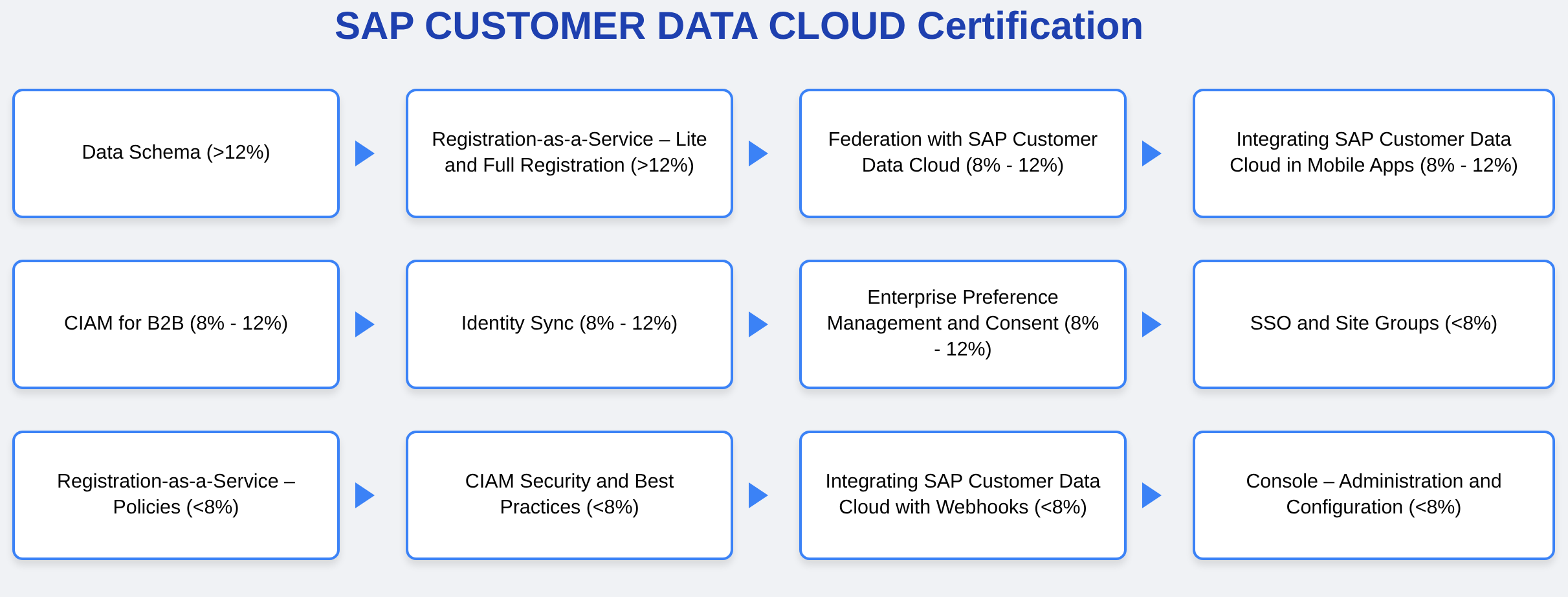
C_C4H620_34 – SAP CUSTOMER DATA CLOUD Certification
Boost your preparation with our trusted SAP C_C4H620_34 certification. This easy-to-follow guide includes actual questions and detailed explanations to help you understand SAP Customer Data Cloud efficiently. Our expertly curated C_C4H620_34 dump reflect the latest format, focusing on the most relevant and frequently tested topics. With these updated materials, you can study smarter and improve your chances of passing the exam with ease.
We offers exact Questions from an actual Exam.
Guaranteed Success in the first attempt.
We'll give you all your money back.
No questions asked.
All orders are Delivered instantly.
Once you will buy any of our products you will be subscribed to free updates for up to 90 days.
We Offers you 24/7 free customer support to make your learning smooth.
$69.00 $115.00
Hurry Up! Offer ends in:
C_C4H620_34 – SAP Customer Data Cloud Certification
Overview:
- Level: Associate
- Exam: 80 questions
- Delivery Methods: Certification for Exam Preparation (PDF Format)
What This Certification Is About
The C_C4H620_34 certification shows that you have the basic knowledge and skills needed to work as a development consultant. This dump proves you understand the core concepts and have the technical abilities to join an project team. When you pass this certification, you demonstrate that you can work effectively on data projects with guidance from experienced team members. This makes it a perfect starting point for anyone beginning their career in Cloud solutions.
The C_C4H620_34 exam is designed as an entry-level qualification, which means it’s ideal for newcomers to the field. It covers all the essential topics you need to know to get started in your Cloud journey.
Furthermore Our latest study guide for C_TFG61_2405 Certification covers every essential concept, making it easier to prepare effectively while improving your confidence before taking the official certification test. Discover everything about SAP C_C4H620_34

What’s Covered in the C_C4H620_34 Certification
This guide shows the main topics you’ll find in the exam. Please note that can change what’s included in the test at any time, so this list gives you a general idea of what to expect.
Data Schema (More than 12%)
You’ll learn how to work with storage in Data Cloud. This includes creating and updating fields through both the visual editor and programming calls.
Basic and Full Registration Services (More than 12%)
This section covers how customers can sign up for accounts on websites. You’ll study simple and detailed registration forms, social media login options, linking accounts together, and step-by-step data collection. The C_C4H620_34 exam tests your ability to build these features into websites using SAP’s tools.
Connecting with Other Systems (8% – 12%)
Learn about different ways to share data between Customer Cloud and other systems. This includes understanding three main connection methods: JWT, OIDC, and SAML.
Mobile App Integration (8% – 12%)
Study how to add Cloud features to mobile apps. You’ll need to understand two different approaches for mobile apps and how to properly manage user sessions. The C_C4H620_34 dump materials cover these mobile development topics in detail.
Business-to-Business Management (8% – 12%)
This topic focuses on managing customer accounts for business clients rather than individual consumers. You’ll learn about organization access control, self-service options for end users, and rule-based permission systems.
Identity Sync (8% – 12%)
Understand how to moves between different systems automatically. You’ll study normal sync processes, error handling, custom workflows, and how to set up sync schedules.
Managing Preferences and Consent (8% – 12%)
Learn the key parts of business-level consent management. This section teaches you how to implement customer consent features with and without SAP’s identity tools, using both visual forms and programming interfaces.
Single Sign-On and Site Groups (Less than 8%)
Study how to let customers use one login across multiple websites and understand risk-based security checks. You’ll learn the setup steps needed to make these features work properly.
Registration Service Rules (Less than 8%)
Learn about the different rule options you can set for registration services and how to configure them correctly.
Security and Best Practices (Less than 8%)
This section covers recommended security practices for cookies, signature checking, token validation, mobile apps, and user experience when working with Cloud, Having C_C4H620_34 certification questions can be helpful for understanding these focused processes.
Webhook Integration (Less than 8%)
Learn how to set up and handle webhook events, which are automatic notifications sent between systems. You’ll also study how to secure these notifications properly.
Administration Console (Less than 8%)
Understand how to manage user groups, applications, permissions, and API keys through Customer main control panel.
